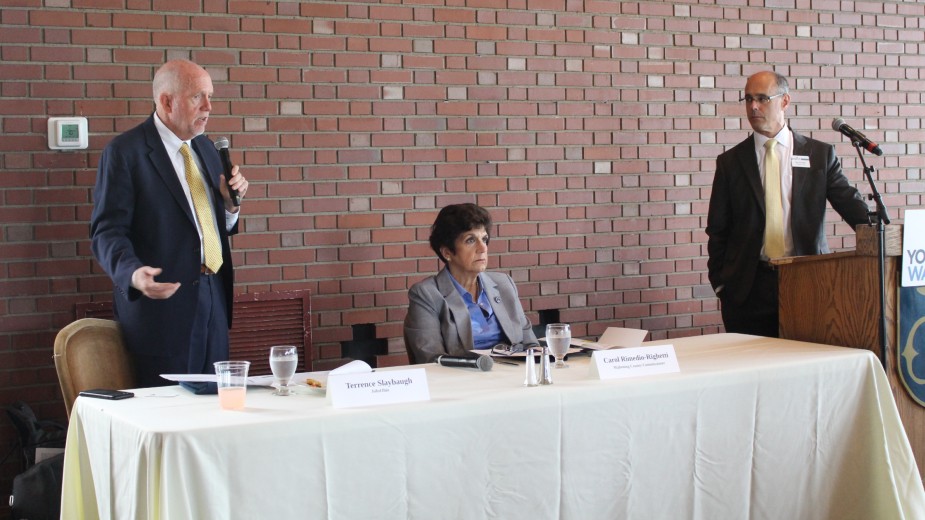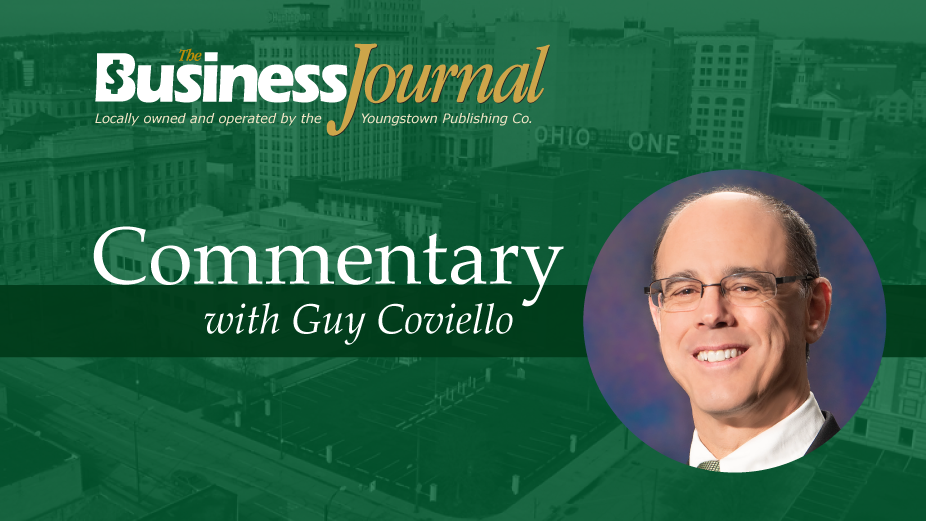ARP Funds Could Provide ‘Generational Opportunity’ for Valley Development
LIBERTY TOWNSHIP, Ohio – American Rescue Plan funds might be limited in scope to addressing community needs that arose from the COVID-19 pandemic, but they can still be used in ways that promote economic development, participants in a Youngstown/Warren Regional Chamber forum said Tuesday.
The latest installment in the chamber’s Lunch & Learn series focused on the approximately $250 million coming to Mahoning Valley communities as a result of federal legislation passed earlier this year. In total, the plan provides $350 billion to state, local, territorial and tribal governments.
Participants in the panel, which was moderated by chamber President and CEO Guy Coviello, were JobsOhio vice president of sites and infrastructure Terrence Slaybaugh, Mahoning County Commissioner Carol Rimedio-Righetti, Warren 6th Ward Councilwoman Cheryl Saffold and Eastgate Regional Council of Governments Executive Director Jim Kinnick.
The $6.3 billion coming to more than 2,300 local governments in Ohio is “an opportunity we’ll probably never see again in our lifetime,” Slaybaugh said. It is a “generational opportunity” for Ohio not only to advance quality of life and economic development in the state, but also to make Ohio “stand out in the Midwest” and be more competitive than the states surrounding it.
JobsOhio, the public-private corporation that spearheads the state’s economic development efforts, is putting together a guidebook that hopefully will be out in early October for communities to use to ensure they are spending the American Rescue Plan funds properly. Federal officials are still finalizing guidelines for how the money can be spent, but the main language in the legislation is that the money must be used to address some impact from the COVID-19 pandemic, he said.
“The guidebook is not to tell communities how to spend the money but really to assist them,” Slaybaugh said. In addition to information about the guidelines, it will provide examples of how the funding can be spent, primarily related to workforce, infrastructure and assisting small businesses that were impacted by the pandemic.
“My telephone has been ringing off the hook” from people inquiring about how the ARP funds will be used in Warren, Saffold said.
Warren officials are conducting a series of forums around the city and the city has an online survey underway to gather input from residents about how to best use the city’s allocation of ARP funds, she said.
“We are hoping that we get a wide response from the citizens because this money has to be spent wisely,” she continued. “I can tell you for the most part that people in my community want some of those funds to come back to the community. We understand that economic development is key to this area, but we also have to make sure that we think about the neighborhoods that have been neglected for a very long time.”
The ARP funding can’t be spent directly on traditional economic development but can be used to provide assistance in neighborhoods specifically affected by the pandemic, Slaybaugh said. That includes help such as job training education, worker support and wraparound services such as transportation and child care.
“We can do things within the guidelines of this ARP money that would fit that category that would help with economic development,” Rimedio-Righetti said.
Mahoning County spent ARP funds to help Oak Hill Collaborative with its efforts to expand broadband, a local need identified during the pandemic, and to help Oh Wow! The Roger & Gloria Jones Children’s Center for Science & Technology, she said. She also pointed to potential use of funds to expand water use to areas affected by the pandemic that also could encourage economic development.
County officials are continuing to take requests for how to use the federal funds. “If it fits and we can help, we will,” she said.
Public transportation is one of the needs Saffold identified. Most of the residents of her neighborhood, which suffers from high unemployment, crime and poverty, want to work, but many of them don’t have transportation to get to parts of the Valley where jobs are available. Some of those jobs are coming to the village of Lordstown, but Warren residents who don’t have their own vehicles have to catch a bus that takes them to Youngstown and then transfer to the route that goes to Lordstown.
“We want a straight route,” she said.
Slaybaugh said local discussions about the funds are ahead of what he is seeing in other communities he has visited.
“I don’t see anyone having the kinds of discussions you’re having,” he said at the Lunch & Learn event. “Things are moving very slowly because a lot of the operational guidelines are not finalized.”
The chamber, at the request of the mayors of Youngstown and Warren, led two communitywide discussions with area leaders, including from the business, economic development and philanthropic communities. The discussion centered on how a portion of the funds allocated to the local communities might be used to accomplish “something transformational that’s valleywide that maybe exceeds the sum of what any individual community can do,” Coviello reported.
When the Valley has been successful in past efforts to secure funding for area projects, having a “regional vision” was cited as a factor, Kinnick said. The top issue identified from a regional perspective was workforce.
“That’s broad. That’s talent retention, attraction, that marketing, but it needs to be a coordinated effort,” he said. The other priorities identified were broadband expansion, infrastructure and utilities and brownfields.
A fifth priority identified was site readiness, Coviello said. Most people believe there are “tons and tons” of available properties for project sites, but “the fact is we are one of the most challenged communities maybe in the whole country in terms of being able to have a site for somebody to be able to build a factory or warehouse,” he explained.
JobsOhio now is chasing 12 “mega projects” that it can’t win without appropriate sites, some of which require 1,000 acres or more, Slaybaugh said. It is working with the Western Reserve Port Authority to get the former BDM Steel Holdings property on the state’s list of authenticated sites.
“There’s a ton of opportunity right now to bring [Ultium Cells] type projects to Ohio and to Youngstown, to this region and one of our challenges is infrastructure and having available sites,” he said. “We probably don’t have a half a dozen sites in the state that we can show right now to a company that’s looking for 100 acres.”
Pictured: Terrence Slaybaugh, JobsOhio’s vice president of sites and infrastructure, speaks at the Youngstown/Warren Regional Chamber’s Lunch & Learn event focusing on how Valley communities can use funds from the American Rescue Plan. Alongside him are Mahoning County Commissioner Carol Rimedio-Righetti and chamber President and CEO Guy Coviello.
Copyright 2024 The Business Journal, Youngstown, Ohio.



